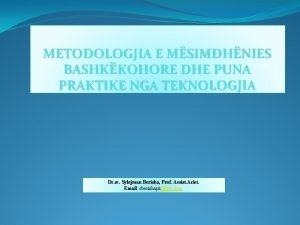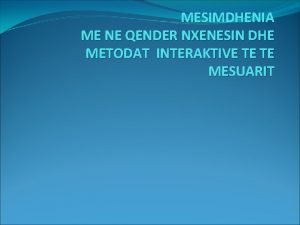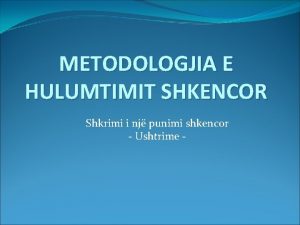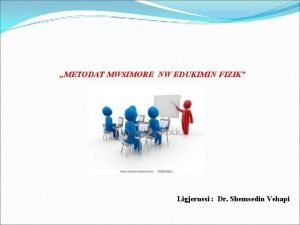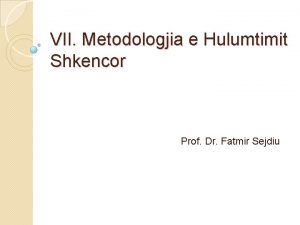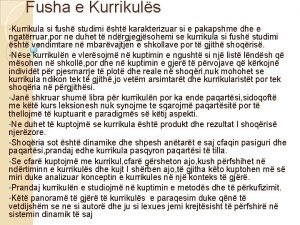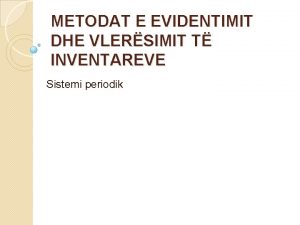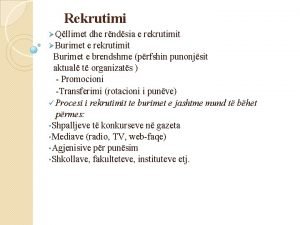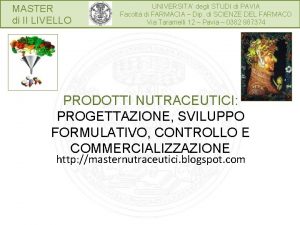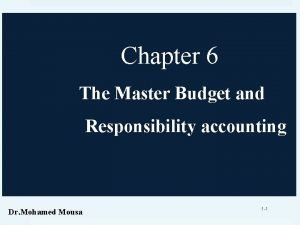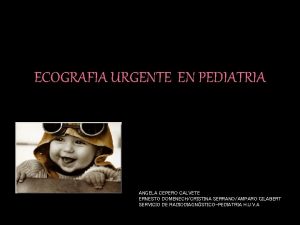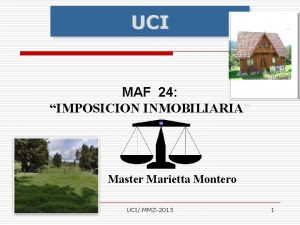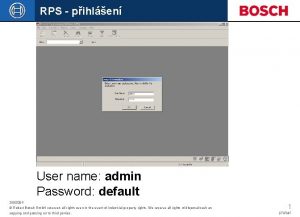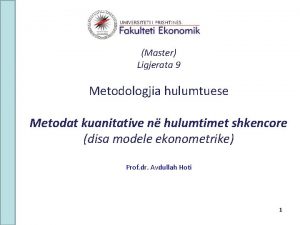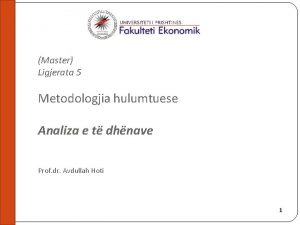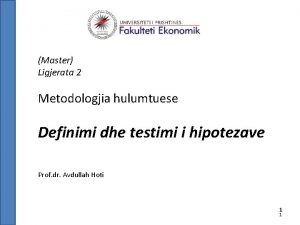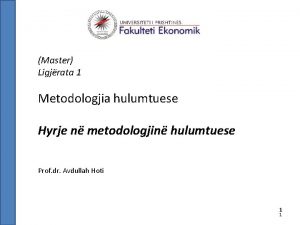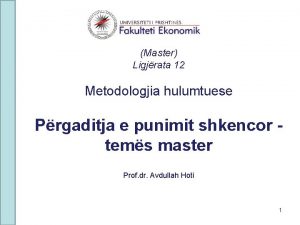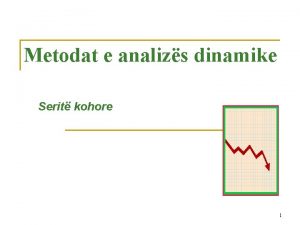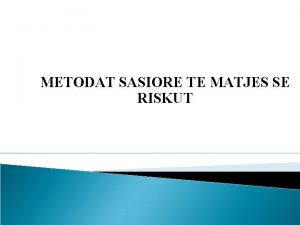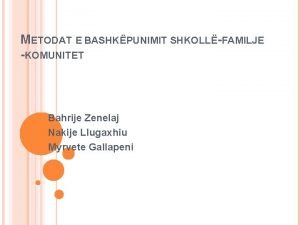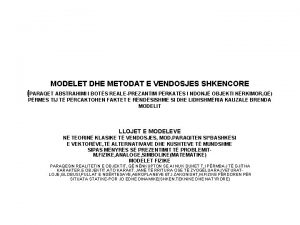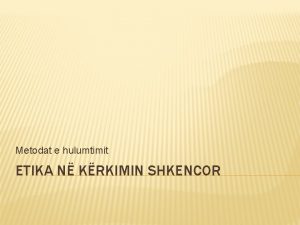Master Ligjerata 10 Metodologjia hulumtuese Metodat kuanitative n






































- Slides: 38

(Master) Ligjerata 10 Metodologjia hulumtuese Metodat kuanitative në hulumtimet shkencore (shembull konkret) Prof. dr. Avdullah Hoti 1

Qëllimi i ligjëratës • Si aplikohen modelet ekonometrike në hulumtime empirike? • Qasja në përgatitjen e një punimi shkencor për publikim. – – – Identifikimi i qëllimeve të hulumtimit Identifikimi i hipotezave Zgjedhja e modelit ekonometrik Vlerësimi/testimi i hipotezave Interpretimi i rezultateve • Të gjitha këto do të diskutohen përmes një shembulli konkret nga një punim i botuar: – Hoti, Avdullah (2009) 'Determinants of emigration and its economic consequences: evidence from Kosova', Southeast European and Black Sea Studies, 9: 4, 435 — 458 2

Determinants of emigration and its economic consequences: evidence from Kosova 3

Context of the investigation: Why dealing with emigration and remittances? • Labour movements affects the economic prospects of countries involved, • In the origin country, emigration: – Reduces the size of the labour force, – Changes its skills composition, – Affects aggregate spending due to remittances, – Produces other second and third round effects (multiplier effects). • Around 20% of Kosova’s population is abroad • Annual remittances are estimated at 13% of GDP 4

Research questions Q 1. Given the lack of data, to provide estimates of emigrants from Kosova, their profile and brain drain, Q 2. What determines emigration decisions Q 3. Employment possibilities at home and abroad (as the driving force of emigration) Q 4. Returns to education for emigrations Q 5. Determinants of incidence and size of remittances 5

Q 1 Estimates of emigrants from Kosova and their profile • • • Emigration existed during the socialism, There is no official data after 1989, Bush (2004): 300 -500 thousand emigrants, Moalla-fetini et al. (2005): 470 thousand Riinvest (2003): 20% of households have at least one member abroad. 6

Q 1 • Profile of emigrants (based on Riinvest HLFS) – 66% males – 35% urban residents » compared to 45% of the total population – 52% age 25 -44 » compared to 29% of the total population – 61% with higher education » compared to 40% of the total population – 49% remit » Average amount remitted per month for those who remit is 347 Euro, 7

Q 1 8

Q 1 9

Q 1 Estimates of the brain drain in Kosova Proportion in the total population * Population Emigrati on rate* Number of emigrants [1] [2] [3] [4]=[2]x[3] Total population 1. 000 2, 400, 000** 0. 067 160, 800 Population of age 25+ 0. 490 1, 176, 000*** 0. 083 97, 608 Less than upper-secondary education 0. 471 553, 896 *** 0. 049 27, 141 Upper-secondary education 0. 405 476, 280 *** 0. 126 60, 011 Higher education 0. 124 145, 824 *** 0. 074 10, 791 Education level of the population aged 25+ Source of data: * Riinvest HLFS of December 2002; ** Estimated by Moalla-Fetini et al. (2005) using the size of the population from the last census of 1981 and assuming a natural growth rate of 2 percent for Albanians and 1. 2 percent for other ethnic groups living in Kosova. This estimate includes emigrants. 10 *** Own calculations by multiplying the respective proportion in the population from column 1 with the total number of population.

Q 2 What determines emigration decisions • Theory of migration: why labour moves? – Employment and wage differentials between home and abroad • The effect of: – Personal characteristics – Household characteristics – Contextual characteristics 11

Q 2 • When a person moves abroad? – Ve and Vs indicate the expected value abroad and at home respectively, – c is the costs of emigration The dep. variable is discrete, taking values of 1 if abroad and 0 if not: 12

Q 2 Data • Riinvest Household and Labour force Survey data: • 1, 252 households are interviewed with 8552 members, • In the estimation, we consider only those of age 16 -64: • 4, 891 observations • Of whom, 431 or 8. 8% are abroad 13

Q 2 Defining the explanatory variables Explanatory variables Definition Personal characteristics Age of the person Education Dummies: less than upper-secondary (the omitted), upper-secondary and higher Marital status Dummy=1 if married, 0 otherwise Household characteristics Household size Number of household members Household incomes €/month per capita without including remittances Household incomes squared €/month per capita without including remittances squared Contextual characteristics Residence Dummy=1 if the person is from urban areas, 0 if from rural areas Regional dummies Dummies for the 7 main regions (omitted dummy for the Prishtina region) 14

Q 2 Findings 15

Q 3 Marginal effects 16

Q 3 Q 3. Employment possibilities at home and abroad as the driving force of emigration • 61% of emigrants aged 16 -64 are employed as compared to 30% of non-migrants, • We investigate the change in the probability of being employed when a person emigrates, • A probit model is estimated: the dependent variable equals 1 if the person is employed in Kosova (in the case of non-migrants) or abroad (in the case of emigrants) and 0 if not. • We use the sample as in the previous estimations. 17

Q 3 Definition of variables • Education dummies that proxy for the potential wage. • Age and age squared account for work experience and also the changing attitudes toward work with age. • Marital status (dummy that equals 1 if married) controls for the effect of family obligations as well as culture, attitudes and family arrangements regarding employment. • Residence: dummy=1 if abroad 18

Q 3 Findings 19

Q 3 Marginal effects 20

Q 4 4. Returns to education for emigrations • Wage differentials due to education among emigrants utilising the Mincerian wage equation • The basic Mincerian wage equation (Mincer, 1974) relates the log wage (ln wi) to years of education (Edi) and experience (Expi) and its square (Expi 2): • Findings indicate if education obtained in Kosova is rewarded in the foreign market. • The sample consists of employed emigrants aged 16 -64 with non-missing data on monthly wages as reported by the household head in Kosova. 21

Q 4 • The explanatory variable: – for human capital: education dummies, – work experience: • age and age squared • years of emigration – marital status (a dummy that equals 1 if married) – gender – the country of emigration • We do not have sufficient observations to estimate separate regressions by gender. We only allow for differences in the intercept. 22

Q 4 Findings 23

Q 5 Q 5. Determinants of incidence and size of remittances • The orthodox theory fails to explain what determines a migrant’s remittances, because it assumes that migration is an individual strategy to maximise income, in which case one would expect to observe zero remittances. • The new economics of migration brings a household perspective to migration decisions, where emigration is a household strategy for allocating labour so as to increase household incomes and reduce the risk 24

Q 5 Motivation for remitting • The motivations for migrant’s remittances are thought to be similar to motivations for other intra-household transfers. • First, migrants may remit induced by altruistic behaviour, where remittances increase with migrant’s incomes and the degree of altruism and decrease with household incomes. • Second, remittances can also reflect migrants’ desires to diversify their portfolios (Bouhga-Hagbe, 2006). • Third, remittances may be viewed as repayments of loans used to finance migration costs and/or migrant’s human capital. • Finally, migrants may remit to ensure that in the future they will be given rights towards their household’s wealth. 25

Q 5 Methodology • We follow the model provided by Funkhouser (1995), where emigrant’s utility function includes the utility of the household left behind: • Where: – Um is the emigrant’s own utility and – Uh is the household utility in the source country (each are dependent on consumption Cm and Ch respectively). • The importance of the utility of the household left behind in the migrant’s own utility U depends on the relationship of the migrant to the household captured by the vector Z. 26

Q 5 We investigate: (i) the probability that an emigrant remits – where yi denotes the observed amount of remittances sent home (in €/month) by the emigrant i. – We estimate a probit model: 27

Q 5 • (ii) determinants of the size of remittances – 49% of emigrants aged 16+ remit (i. e. yi>0). – For the rest with yi=0 (corner solution), the dependent variable is a continuous variable, but truncated at zero. – The Tobit model handles the situations when y is characterised by the corner solution – Where • yi* is the latent variable and yi is its observed counterpart, • xi is a vector of explanatory variables expected to affect yi*, • is the vector of parameters to be estimated 28

Q 5 • The Tobit model involves estimating • The direction (i. e. the sign) of the effect of explanatory variables xi on yi is the same with regard to Pr(yi>0 | xi) and E(yi | yi>0, xi, ). • The marginal effect can be split into two parts. – First, if yi=0, as xi increases then the probability that yi>0 increases. – Second, if yi>0 as xi increases then the mean response of yi increases. 29

Q 5 Defining the explanatory variables 30

Q 5 Findings: the probability of remitting 31

Q 5 Marginal effects • For a representative male who is: – – – – 31 years old, with higher education, married, employed, from urban areas, from a household with 10 members, with household incomes per capita without including remittances at the sample average (€ 37 per month) and – who has 8 years of emigration, the probability of remitting is 0. 72. • For a similar female, this probability is 0. 36. • Doubling the household incomes decreases the probability of remitting by 5 percentage points for males and by 4 percentage points for females. • Increasing the years in emigration by one year ceteris paribus, increases the probability of remitting by 1 percentage point for males and by 2 percentage points 32 for females.

Q 5 Findings: The size of remittances (the Tobit model) 33

Q 5 Marginal effects (conditional and unconditional) • For all emigrants, males remit 42 percent more than females (column 3), – Of those who remit, males remit 32 percent more than females (column 4). • Those who are employed remit 165 percent more than those who are not employed. – Of the emigrants who remit, the employed remit 138 percent more than those who are not employed. • For all emigrants, a 1 percent increase in household incomes is associated with a decrease in remittances by 0. 137 percent ceteris paribus. – Of the emigrants who remit, as the household incomes increase by 1 percent the amount remitted decreases by 0. 099 percent • Finally, for all emigrants an additional year of emigration increases remittances by 3. 7 percent, – of emigrants who remit the amount remitted increases by 2. 7 percent. 34

Conclusions (1) 1. We provided evidence on emigration and remittances in Kosova 2. The likelihood of emigration decreases with age and increases with education and household size. 3. Some indirect evidence for the positive effect of emigration networks. 4. Emigration decisions are expected to be driven by the perceived higher chances of employment upon emigration. 35

Conclusions (2) 5. No evidence that education (and experience) obtained in Kosova is rewarded in the foreign labour market. 6. Emigrants who are employed are more likely to remit than the non-employed emigrants. 7. The incidence of remitting and the amount remitted decrease with the household income in Kosova and increase with years of emigration. 36

Conclusions (3) • These findings can be used to provide a better estimation (and forecast) of remittances. This may contribute to better estimation of the consumption and savings by households and therefore improve the national accounts estimates in Kosova. 37

Thank you! 38
 Metodologjia shembull
Metodologjia shembull Metodologjia e hulumtimit master pyetje pergjigje
Metodologjia e hulumtimit master pyetje pergjigje Metodologjia e hulumtimit master pyetje pergjigje
Metodologjia e hulumtimit master pyetje pergjigje Metodologjia e mesimdhenies
Metodologjia e mesimdhenies Metodat e mesimdhenies ne ciklin e ulet
Metodat e mesimdhenies ne ciklin e ulet Metodologjia e hulumtimit punim seminarik
Metodologjia e hulumtimit punim seminarik Metoda verbale
Metoda verbale Llojet e hulumtimit shkencor
Llojet e hulumtimit shkencor Metodologjia shembull
Metodologjia shembull Metodologjia e perdorur
Metodologjia e perdorur Gerzheta permbledhje
Gerzheta permbledhje Projekt hulumtues
Projekt hulumtues Fushat e kurrikules
Fushat e kurrikules Fifo metoda
Fifo metoda Metoda sasiore
Metoda sasiore Metodat e rekrutimit
Metodat e rekrutimit Fontys pro
Fontys pro Ulb master
Ulb master Scrum master servant leader
Scrum master servant leader Presentatie structuur
Presentatie structuur Ghost in my room asl translation
Ghost in my room asl translation Master test plan
Master test plan I'll be a friend to jesus
I'll be a friend to jesus Lidl leadership principles
Lidl leadership principles Diplomski rad pravila
Diplomski rad pravila Master farmacia pavia
Master farmacia pavia Master x secretary post type
Master x secretary post type Sql server enterprise master data management
Sql server enterprise master data management Project master schedule
Project master schedule Chapter 6 master budget and responsibility accounting
Chapter 6 master budget and responsibility accounting Master ecografia urgenza
Master ecografia urgenza Open dag diergeneeskunde
Open dag diergeneeskunde Sap txstate
Sap txstate Master tef
Master tef Master production schedule problems
Master production schedule problems Bvale
Bvale Inmobiliaria master
Inmobiliaria master Master name title
Master name title Bosch fpa-5000 master password
Bosch fpa-5000 master password



